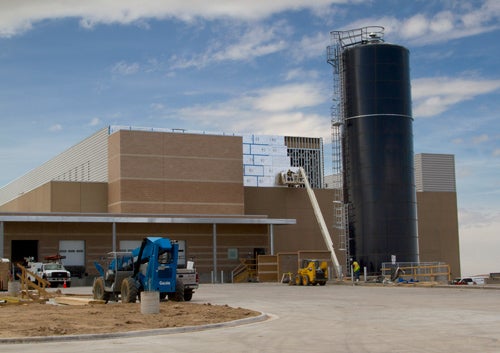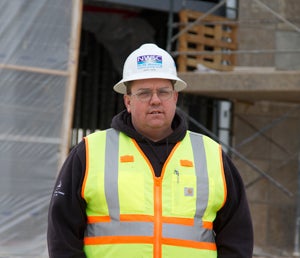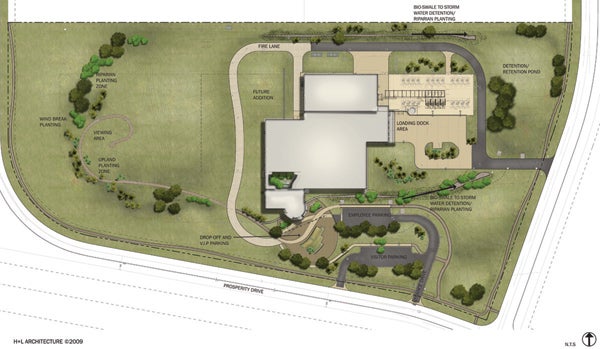Efficient by design
Green elements abound as a new supercomputing center takes shape
May 6, 2011 - by Staff
May 6, 2011 - by Staff
6 May 2011 • In a business park just southwest of downtown Cheyenne, the scene has been changing almost daily as construction unfolds on the NCAR–Wyoming Supercomputing Center. The building construction is expected to reach substantial completion by the end of summer 2011, after which a new supercomputing system will be commissioned and installed. Full research operations are set to begin by spring 2012.

This view of the NWSC’s east side shows the main receiving area where supercomputers will be moved into the building. The black chilled water storage tank at right can hold up to 135,000 gallons of water, kept at around 65°F (18°C). (©UCAR. This image is freely available for media and nonprofit use.)
NWSC is designed to be a highly energy-efficient computing center. “Right now we’re on track for LEED Gold,” says NWSC construction manager Gary New. He’s referring to one of the highest green-building ratings from the U.S. Green Building Council’s (USGBC’s) Leadership in Energy and Environmental Design (LEED) building certification system.
Because large computing centers use a good deal of power but have relatively few human occupants, it’s challenging for them to score highly on standard measures of efficiency such as LEED ratings. Another scale designed expressly for data centers is power usage effectiveness (PUE), the ratio of a building’s total power usage to the amount used for primary computing. The PUE ratio for NWSC is expected to be less than 1.1—which means that more than 90% of the center’s energy will go directly toward number-crunching. Most data centers have PUEs of 1.5 or greater.
With ample room for NWSC to expand on its site, the initial construction will include two side-by-side modules, dubbed A and B , with the B module set to be the first one occupied. Each module includes a large computing room upstairs and dedicated infrastructure below in a raised floor space that’s a full 3 meters (10 feet) high. The design allows for two additional modules to be built if the need arises.

NCAR’s Gary New is providing on-site supervision for NWSC construction. Once the building is complete, he’ll serve as facility manager. About 20 NCAR staff will work at the center; the rest of NCAR’s Computational & Information Systems Laboratory will remain in Boulder. (©UCAR. This image is freely available for media and nonprofit use.)
“The beauty of this raised floor is that we can fully outfit infrastructure for a supercomputing system from below without disrupting any of the raised-floor tiles above and the proper air flow to the computing equipment,” says New. “We won’t need to move the tiles on the raised floor until we’re ready to install the cabinets.”
The procurement process for the first major NWSC machine is now under way, says NCAR’s Anke Kamrath. “Acquiring a supercomputer is a reasonably lengthy undertaking that can often take more than a year,” notes Kamrath. “This level of supercomputing is a highly specialized area, given the research requirements for such machines. We’re in the ‘silent period’ of the competitive process right now as we start to review proposals, so we are bound by confidentiality.”
NWSC construction is being funded primarily by NSF, the state of Wyoming, and the University of Wyoming, with additional support from Cheyenne LEADS, the Wyoming Business Council, and Cheyenne Light, Fuel and Power. Along with serving researchers from across the nation in the atmospheric and related sciences as well as a range of other disciplines, the center will also house a premier data storage and archival facility.
A slideshow at NCAR & UCAR Staff Notes includes more photos of NWSC at mid-construction (late March 2011).

The NWSC site includes ample room for expansion. (©H+L Architecture.)